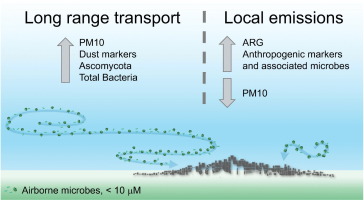当前位置:
X-MOL 学术
›
Sci. Total Environ.
›
论文详情
Our official English website, www.x-mol.net, welcomes your feedback! (Note: you will need to create a separate account there.)
Links between airborne microbiome, meteorology, and chemical composition in northwestern Turkey.
Science of the Total Environment ( IF 9.8 ) Pub Date : 2020-03-26 , DOI: 10.1016/j.scitotenv.2020.138227 Naama Lang-Yona 1 , Fatma Öztürk 2 , Daniella Gat 3 , Merve Aktürk 2 , Emre Dikmen 2 , Pavlos Zarmpas 4 , Maria Tsagkaraki 4 , Nikolaos Mihalopoulos 4 , Aşkın Birgül 5 , Perihan Binnur Kurt-Karakuş 5 , Yinon Rudich 3
Science of the Total Environment ( IF 9.8 ) Pub Date : 2020-03-26 , DOI: 10.1016/j.scitotenv.2020.138227 Naama Lang-Yona 1 , Fatma Öztürk 2 , Daniella Gat 3 , Merve Aktürk 2 , Emre Dikmen 2 , Pavlos Zarmpas 4 , Maria Tsagkaraki 4 , Nikolaos Mihalopoulos 4 , Aşkın Birgül 5 , Perihan Binnur Kurt-Karakuş 5 , Yinon Rudich 3
Affiliation

|
The composition of atmospheric aerosols is dynamic and influenced by their emission sources, organic and inorganic composition, transport pathways, chemical and physical processes, microorganisms' content and more. Characterization of such factors can improve the ability to evaluate air quality and health risks under different atmospheric scenarios. Here we investigate the microbial composition of the atmospheric particulate matter (<10 μm; PM10), sampled in Bolu, Turkey, and the linkage to the chemical composition changes, and different environmental factors. We show distinct differences between aerosol composition of different sources and air-mass transport patterns, sampled in July-August 2017 and in February 2018. The summer samples had a typical northern component air mass trajectories and higher local wind speed. They were characterized by high PM10 levels, marine and mineral dust tracers and high relative abundance of Ascomycota, suggesting long-range transport of the particles from remote sources. In contrast, samples collected in February were characterized by a dominant contribution of southern air masses, and low wind speed. They had low PM10 values, higher relative abundance of antibiotic resistance genes and anthropogenic ions related to local industries and farming, suggesting a dominance of local sources. With the microbiome analyses reported here for the first time for this region, we show good agreement between airborne microbial composition, aerosol mass load, chemistry, and meteorology. These results allow better air quality evaluation and prediction capabilities.
中文翻译:

土耳其西北部的空气传播微生物组,气象学和化学成分之间的联系。
大气气溶胶的组成是动态的,并受其排放源,有机和无机组成,运输途径,化学和物理过程,微生物含量等的影响。表征这些因素可以提高评估不同大气情景下空气质量和健康风险的能力。在这里,我们调查了在土耳其博卢采样的大气颗粒物(<10μm; PM10)的微生物组成,以及与化学成分变化和不同环境因素有关的联系。我们显示出不同来源的气溶胶成分与空气质量传输模式之间的明显差异,分别在2017年7月至8月和2018年2月采样。夏季采样具有典型的北部成分空气质量轨迹和较高的局部风速。它们的特点是PM10含量高,海洋和矿物尘埃示踪剂以及子囊菌的相对丰度高,表明这些颗粒物是从遥远的地方进行远距离运输的。相比之下,2月份收集的样品的特征是南部空气质量占主导地位,风速低。他们的PM10值较低,抗生素抗性基因的相对丰度较高,与当地工业和农业有关的人为离子较高,表明当地来源占主导地位。在这里首次报告了该地区的微生物组分析之后,我们证明了空气传播的微生物成分,气溶胶质量负荷,化学和气象学之间的良好一致性。这些结果可提供更好的空气质量评估和预测能力。海洋和矿物尘埃示踪剂以及相对较高的子囊菌含量,这表明从遥远的地方可以远距离运送颗粒。相比之下,2月份收集的样品的特征是南部空气质量占主导地位,风速低。他们的PM10值低,相对较高的抗生素抗性基因和与当地工业和农业有关的人为离子,表明当地来源占主导地位。在这里首次报告了该地区的微生物组分析之后,我们证明了空气传播的微生物成分,气溶胶质量负荷,化学和气象学之间的良好一致性。这些结果可提供更好的空气质量评估和预测能力。海洋和矿物尘埃示踪剂以及相对较高的子囊菌含量,这表明从遥远的地方可以远距离运送颗粒。相比之下,2月份收集的样品的特征是南部空气质量占主导地位,风速低。他们的PM10值低,相对较高的抗生素抗性基因和与当地工业和农业有关的人为离子,表明当地来源占主导地位。在这里首次报告了该地区的微生物组分析之后,我们证明了空气传播的微生物成分,气溶胶质量负荷,化学和气象学之间的良好一致性。这些结果可提供更好的空气质量评估和预测能力。2月份收集的样本的特点是南部空气质量占主导地位,风速低。他们的PM10值低,相对较高的抗生素抗性基因和与当地工业和农业有关的人为离子,表明当地来源占主导地位。在这里首次报告了该地区的微生物组分析之后,我们证明了空气传播的微生物成分,气溶胶质量负荷,化学和气象学之间的良好一致性。这些结果可提供更好的空气质量评估和预测能力。2月份收集的样本的特点是南部空气质量占主导地位,风速低。他们的PM10值低,相对较高的抗生素抗性基因和与当地工业和农业有关的人为离子,表明当地来源占主导地位。在这里首次报告了该地区的微生物组分析之后,我们证明了空气传播的微生物成分,气溶胶质量负荷,化学和气象学之间的良好一致性。这些结果可提供更好的空气质量评估和预测能力。在这里首次报告了该地区的微生物组分析之后,我们证明了空气传播的微生物成分,气溶胶质量负荷,化学和气象学之间的良好一致性。这些结果可提供更好的空气质量评估和预测能力。在这里首次报告了该地区的微生物组分析之后,我们证明了空气传播的微生物成分,气溶胶质量负荷,化学和气象学之间的良好一致性。这些结果可提供更好的空气质量评估和预测能力。
更新日期:2020-03-27
中文翻译:

土耳其西北部的空气传播微生物组,气象学和化学成分之间的联系。
大气气溶胶的组成是动态的,并受其排放源,有机和无机组成,运输途径,化学和物理过程,微生物含量等的影响。表征这些因素可以提高评估不同大气情景下空气质量和健康风险的能力。在这里,我们调查了在土耳其博卢采样的大气颗粒物(<10μm; PM10)的微生物组成,以及与化学成分变化和不同环境因素有关的联系。我们显示出不同来源的气溶胶成分与空气质量传输模式之间的明显差异,分别在2017年7月至8月和2018年2月采样。夏季采样具有典型的北部成分空气质量轨迹和较高的局部风速。它们的特点是PM10含量高,海洋和矿物尘埃示踪剂以及子囊菌的相对丰度高,表明这些颗粒物是从遥远的地方进行远距离运输的。相比之下,2月份收集的样品的特征是南部空气质量占主导地位,风速低。他们的PM10值较低,抗生素抗性基因的相对丰度较高,与当地工业和农业有关的人为离子较高,表明当地来源占主导地位。在这里首次报告了该地区的微生物组分析之后,我们证明了空气传播的微生物成分,气溶胶质量负荷,化学和气象学之间的良好一致性。这些结果可提供更好的空气质量评估和预测能力。海洋和矿物尘埃示踪剂以及相对较高的子囊菌含量,这表明从遥远的地方可以远距离运送颗粒。相比之下,2月份收集的样品的特征是南部空气质量占主导地位,风速低。他们的PM10值低,相对较高的抗生素抗性基因和与当地工业和农业有关的人为离子,表明当地来源占主导地位。在这里首次报告了该地区的微生物组分析之后,我们证明了空气传播的微生物成分,气溶胶质量负荷,化学和气象学之间的良好一致性。这些结果可提供更好的空气质量评估和预测能力。海洋和矿物尘埃示踪剂以及相对较高的子囊菌含量,这表明从遥远的地方可以远距离运送颗粒。相比之下,2月份收集的样品的特征是南部空气质量占主导地位,风速低。他们的PM10值低,相对较高的抗生素抗性基因和与当地工业和农业有关的人为离子,表明当地来源占主导地位。在这里首次报告了该地区的微生物组分析之后,我们证明了空气传播的微生物成分,气溶胶质量负荷,化学和气象学之间的良好一致性。这些结果可提供更好的空气质量评估和预测能力。2月份收集的样本的特点是南部空气质量占主导地位,风速低。他们的PM10值低,相对较高的抗生素抗性基因和与当地工业和农业有关的人为离子,表明当地来源占主导地位。在这里首次报告了该地区的微生物组分析之后,我们证明了空气传播的微生物成分,气溶胶质量负荷,化学和气象学之间的良好一致性。这些结果可提供更好的空气质量评估和预测能力。2月份收集的样本的特点是南部空气质量占主导地位,风速低。他们的PM10值低,相对较高的抗生素抗性基因和与当地工业和农业有关的人为离子,表明当地来源占主导地位。在这里首次报告了该地区的微生物组分析之后,我们证明了空气传播的微生物成分,气溶胶质量负荷,化学和气象学之间的良好一致性。这些结果可提供更好的空气质量评估和预测能力。在这里首次报告了该地区的微生物组分析之后,我们证明了空气传播的微生物成分,气溶胶质量负荷,化学和气象学之间的良好一致性。这些结果可提供更好的空气质量评估和预测能力。在这里首次报告了该地区的微生物组分析之后,我们证明了空气传播的微生物成分,气溶胶质量负荷,化学和气象学之间的良好一致性。这些结果可提供更好的空气质量评估和预测能力。

























 京公网安备 11010802027423号
京公网安备 11010802027423号